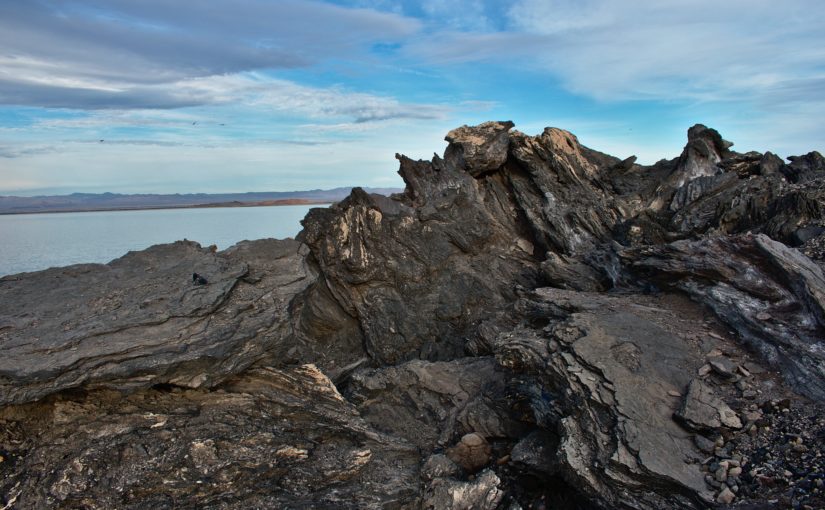On Saturday, I met up with some friends in San Diego and went out to another adventure at the South End of the Salton Sea. We ended up spending all afternoon, into the evening, exploring only one of the active volcanoes, Obsidian Butte, and the nearby shores of the giant lake.
Obsidian Butte, like nearly all of the Salton Buttes, isn’t marked very well, and can be difficult to find, without any directions leading you there. Fortunately, I spent some time looking at topographic maps and getting a general feel for what to expect before heading that way. Loaded with GPS coordinates and experience from the last outing to the area, we set out.
We took an obvious route that sent us up Gentry Road. As we passed the large geothermal plant on the West side of the road, McKendry Road followed almost immediately after, and we set off down this dirt road. Although this included a large mud puddle due to all of the recent rains, we were easily able to make our way through, finding a nice parking spot for the nearby National Wildlife Refuge.
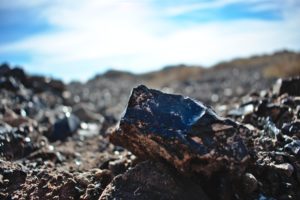 The road could be taken all of the way to Obsidian Butte, but we opted to walk it instead, taking in the wildlife and nature that surrounded us. Even so, it wasn’t long before fields of obsidian came into obvious view. Although I have previously walked through large obsidian flows like this, it’s always an impressive feat, and I also enjoyed watching my friends experience such a thing for the first time.
The road could be taken all of the way to Obsidian Butte, but we opted to walk it instead, taking in the wildlife and nature that surrounded us. Even so, it wasn’t long before fields of obsidian came into obvious view. Although I have previously walked through large obsidian flows like this, it’s always an impressive feat, and I also enjoyed watching my friends experience such a thing for the first time.
The obsidian flow seems to go on forever, once you end up inside of it. Only the mining operations right in the middle of it, and the several related roads nearby, prove to be distracting eye sores for quite a while. We climbed over a bunch of the flow before making our ways onto the salty “beaches” of the Salton Sea.
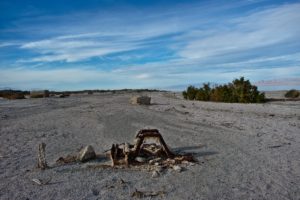 I was amazed to find the obsidian and pumice still continuing all of the way into the water, even surrounding the remains of old development from when people actually thought the Salton Sea might become a tourist destination–before the salinity and agriculture run-off began lining the beaches with the corpses of dead fish and birds, and the bacteria began emanating the awful stench now easily associated to the entire area.
I was amazed to find the obsidian and pumice still continuing all of the way into the water, even surrounding the remains of old development from when people actually thought the Salton Sea might become a tourist destination–before the salinity and agriculture run-off began lining the beaches with the corpses of dead fish and birds, and the bacteria began emanating the awful stench now easily associated to the entire area.
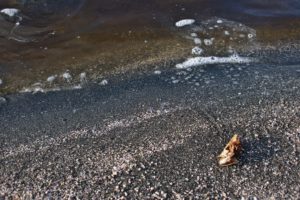 Thankfully for us, the smell wasn’t bad on this side of the lake for the day. Although we would get the occasional whiff of the stench, we could bare to gaze at the murkiness of the water and the shores littered with barnacle shells and fish and bird skeletons. More fascinating than any other shoreline I had been on along this lake, however, was the outcroppings of obsidian and pumice, often surprisingly crusted with salt and sediment from the once much higher levels of the lake.
Thankfully for us, the smell wasn’t bad on this side of the lake for the day. Although we would get the occasional whiff of the stench, we could bare to gaze at the murkiness of the water and the shores littered with barnacle shells and fish and bird skeletons. More fascinating than any other shoreline I had been on along this lake, however, was the outcroppings of obsidian and pumice, often surprisingly crusted with salt and sediment from the once much higher levels of the lake.
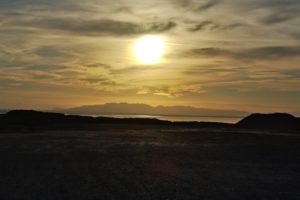 We ultimately stayed, exploring all over the area of this active volcano and the beaches of the lake til near to sunset. Climbing over the obsidian, gazing at the vast numbers of birds calling this place their home for the time. It was a wonderful day at this often overlooked, often underappreciated landscape.
We ultimately stayed, exploring all over the area of this active volcano and the beaches of the lake til near to sunset. Climbing over the obsidian, gazing at the vast numbers of birds calling this place their home for the time. It was a wonderful day at this often overlooked, often underappreciated landscape.
